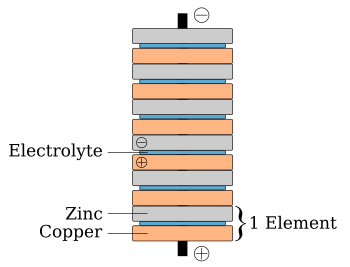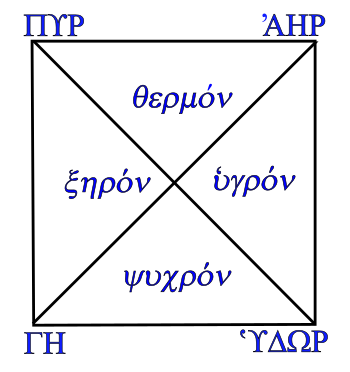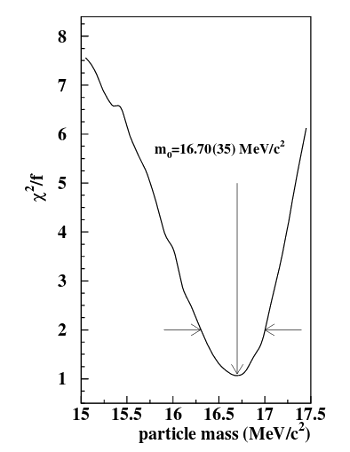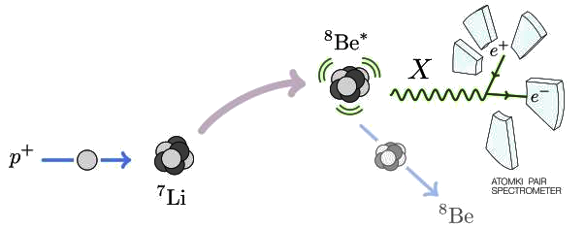Fifth Force
September 12, 2016
In the dim past, when the only manifestation of
electricity was the
attraction of bits of
paper to rubbed
amber, and
magnetism was known only through attraction of
iron to
lodestone, electricity and magnetism were considered to be two different things. The development of electrical
technology after the time of
Alessandro Volta (1745-1827) enabled
Hans Christian Ørsted (1777-1851) to discover in 1820 that an
electric current will produce a
magnetic field.

A Voltaic pile.
In my own experiments, a US dime and US penny, separated by a piece of paper soaked in distilled vinegar, gave 2.01 volts.
(Wikimedia Commons image by Luigi Chiesa, modified.)
In 1831,
Michael Faraday (1791-1867) discovered that passage of a
magnet through a
coil of wire produces electricity, a
phenomenon known as
electromagnetic induction. In 1865,
James Clerk Maxwell (1831-1879) published the paper,
A Dynamical Theory of the Electromagnetic Field, in the
Philosophical Transactions of the Royal Society. This established the idea that
light is an
electromagnetic wave, and electricity and magnetism were combined in a single
electromagnetic force.
At that point, there were just two known
fundamental interactions,
gravitation and electromagnetism. The development of
nuclear physics resulted in the addition of two other fundamental interactions, the
strong nuclear force, and the
weak nuclear force, bringing the total number of fundamental forces to four. While one
theory suggests that electromagnetism and the weak nuclear force are actually manifestations of a single force, the
electroweak interaction, there presently appear to be four forces of
nature.
Four forces would have appealed to
Aristotle (384-322 BC, see figure), who acknowledged gravity in the sense of objects seeking their desired resting place,[1] and likely knew of the electrostatic properties of amber, since these were described by
Thales of Miletus (c.624 - c. 546 BC) and
Theophrastus (c. 371 - c. 287 BC). I wrote about Thales and Theophrastus is a
recent article (Triboelectric Generators, February 8, 2016).

The four classical elements (Earth ΓΗ, Air ʾΑΗΡ, Fire ΠΥΡ, and Water ʿΥΔΩΡ), along with the four qualities of matter (Dry ξηρον, Wet ʿυγρον, Hot θερμον, Cold ψυχρον).
(Created using Inkscape. Click for larger image.)
Since our knowledge of the fundamental forces has been faulty in the past, there first being two, then three, then two again, and now four, how certain are we that there are just four forces? There might be a
fifth force lurking somewhere, just out of reach of our
observations. That idea captured the imagination of
Austro-Hungarian physicist,
Loránd Eötvös (1848-1919), who performed a series of
Cavendish balance measurements, now called the
Eötvös experiment, in 1885-1919. These experiments found no fifth force to a
resolution of 100
parts-per-million (ppm). Subsequent experiments improved this resolution to 0.1 ppm.
In 1986, a group of physicists reexamined Eötvös'
data and found a correlation of intermediate range force with a
physical property known as
hypercharge.[2-3] The presumed fifth force seemed to operate over a range of tens, to hundreds, of
meters, and not over
cosmological distances where divergence of gravity would have been noted. This observation inspired a series of experiments, the result was not confirmed, but experiments continue to the present.[4]
A fifth force may exist, but not the type that would have been detected in such experiments.[5-10] A recent paper in
Physical Review Letters[5] contains an
analysis of a 2015 study by
Hungarian physicists that detected a possibly new
particle.[11] The Hungarian
research team supposed that this particle might be a
dark photon. The new interpretation is that it might be a "
protophobic X
boson," a particle that moderates a fifth force between
electrons and
neutrons at close range. This force is selective and extremely weak, and that's why it's remained undetected until now.[5,9]

Determination of the mass of the discovered particle by the χ2/f method.
This is a small mass in this era of a Higgs boson with a mass of 125 GeV/c2.
(Fig. 5 of Ref. 11.)[11])
The details of the observed
decay of
excited beryllium-8 nuclei can be explained by the existence of a new particle that's just thirty times heavier than an electron.[6,10-11] If this particle is a fifth-force boson, it has a range of just 12
femtometers (fm). The force operates on
up and
down quarks and electrons, and it's less for
protons than
neutrons. What's especially interesting is that it might explain the
anomalous magnetic moment of the muon, a problem of long standing.[5]

The addition of a proton to lithium converts it to beryllium in an excited state. This excited state apparently releases a fifth-force boson X that decays to an electron-positron pair. (UC Riverside image.)
The experimental research team didn't claim a fifth-force particle, since it wasn't clear whether the particle was a matter particle or a force-carrying particle.[6] Follow-up experiments should happen quite quickly, since this is a low
energy nuclear reaction, and many
laboratories have the required
equipment.[9]
While the
Standard Model has persisted for quite some time, resilient against a barrage of experimental tests, it can't explain gravity, and it doesn't explain
dark matter particles.[10] If a fifth-force boson has been discovered, this new force might be
unified with the weak and strong nuclear forces to obtain a more fundamental force.[6]
Says
Philip 'Flip' Tanedo, an
assistant professors of
physics at the
University of California, Irvine
,
"We think that the Hungarian anomaly is interesting and our model is proof that consistent theories can be constructed... We're not saying that a fifth force has been discovered – only that we can pass the first consistency check... The next big check is for other experiments to confirm the anomaly. Our paper lays down the framework for how other types of experiments can definitely check or refute the original Hungarian result. If it ends up being real, that would be a huge deal in our field."[8]
As one physicist was quoted in the
Daily Mail, "We explore ideas... Probably most of ideas are wrong—but we learn from them, and we propose better ideas."[10]
References:
- Aristotle, "Physics," Book IV, Part 1, R. P. Hardie and R. K. Gaye, Trans., MIT Internet Classics Archive.
- Ephraim Fischbach, Daniel Sudarsky, Aaron Szafer, and Carrick Talmadge, and S.H. Aronson, "Reanalysis of the Eötvös experiment," Phys. Rev. Lett. vol. 56, no. 1 (January 6, 1986), pp. 3-6, DOI:http://dx.doi.org/10.1103/PhysRevLett.56.3.
- L. Bod, E. Fischbach, G. Marx And Maria Náray-Ziegler, "One Hundred Years Of The Eötvös Experiment," Hungarian Academy of Sciences Web Site, August 31, 1990.
- T. A. Wagner, S. Schlamminger, J. H. Gundlach, and E. G. Adelberger, "Torsion-balance tests of the weak equivalence principle," arXiv, July 10, 2016.
- Jonathan L. Feng, Bartosz Fornal, Iftah Galon, Susan Gardner, Jordan Smolinsky, Tim M. P. Tait, and Philip Tanedo, "Protophobic Fifth-Force Interpretation of the Observed Anomaly in 8Be Nuclear Transitions," Phys. Rev. Lett., vol. 117, no. 7 (August 12. 2016), Article No. 071803. A version of this paper can be found at arXiv.
- UCI physicists confirm possible discovery of fifth force of nature, University of California, Irvine, Press Release, August 15, 2016.
- Jonathan L. Feng, Bartosz Fornal, Iftah Galon, Susan Gardner, Jordan Smolinsky, Tim M. P. Tait, and Philip Tanedo, "Particle Physics Models for the 17 MeV Anomaly in Beryllium Nuclear Decays," arXiv, August 11, 2016.
- Sean Nealon, "Nuclear Puzzle May Be Clue to Fifth Force," University of California, Riverside, Today, August 17, 2016.
- Weston Williams, "Have scientists discovered a fifth fundamental force of nature?" Christian Science Monitor, August 16, 2016.
- Mark Prigg, "New hints of a fifth fundamental force: 'Revolutionary' X boson could rewrite laws of physics - if it really exists," Daily Mail, August 15, 2016.
- A.J. Krasznahorkay, M. Csatlós, L. Csige, Z. Gácsi, J. Guly´s, M. Hunyadi, T.J. Ketel, A. Krasznahorkay, I. Kuti, B.M. Nyakó, L. Stuhl, J. Timár, T.G. Tornyi, and Zs. Vajta, "Observation of Anomalous Internal Pair Creation in 8Be: A Possible Signature of a Light, Neutral Boson," arXiv, April 7, 2015.
Permanent Link to this article
Linked Keywords: Electricity; electrostatics; electrostatic attraction; paper; amber; magnetism; iron; lodestone; technology; Alessandro Volta (1745-1827); Hans Christian Ørsted (1777-1851); electric current; magnetic field; Voltaic pile; experiment; US dime; US penny; distilled vinegar; volt; Wikimedia Commons; Luigi Chiesa; Michael Faraday (1791-1867); magnet; solenoid; coil of wire; phenomenon; electromagnetic induction; James Clerk Maxwell (1831-1879); scientific literature; A Dynamical Theory of the Electromagnetic Field; Philosophical Transactions of the Royal Society; light; electromagnetic radiation; electromagnetic wave; electromagnetism; electromagnetic force; fundamental interaction; gravity; gravitation; nuclear physics; strong nuclear force; weak nuclear force; theory; electroweak interaction; nature; Aristotle; Thales of Miletus (c.624 - c. 546 BC); Theophrastus (c. 371 - c. 287 BC); four classical elements; Inkscape; fifth force; observation; Austria-Hungary; Austro-Hungarian; physicist; Loránd Eötvös (1848-1919); Cavendish experiment; Cavendish balance; Eötvös experiment; resolution; parts-per-million; data; physical property; hypercharge; meter; cosmology; cosmological; Physical Review Letters; analysis; Hungary; Hungarian; elementary particle; research; dark photon; protophobic; boson; electron; neutron; mass; chi-squared test; Higgs boson; electronvolt; GeV; speed of light; c; radioactive decay; excited state; beryllium-8 nuclei; femtometer; up quark; down quark; quark; proton; anomalous magnetic dipole moment; anomalous magnetic moment of the muon; lithium; beryllium; pair production; electron-positron pair; energy; nuclear reaction; laboratory; equipment; Standard Model; dark matter; Grand Unified Theory; Philip 'Flip' Tanedo; assistant professor; physics; University of California, Irvine; anomaly; conceptual model; sanity check; consistency check; Daily Mail; Aristotle, "Physics," Book IV, Part 1, R. P. Hardie and R. K. Gaye, Trans., MIT Internet Classics Archive.